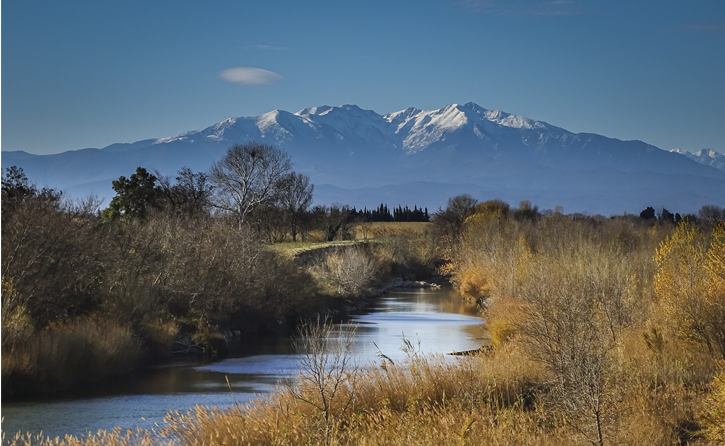Roussillon: ‘Three rivers run through it’
Roussillon’s three main rivers make their way across Roussillon from West to East to reach the Mediterranean sea. The most northern is the Agly, flowing next to the renown villages of Lesquerde, Caramany, Latour de France and Rivesaltes. To the South, running through the City of Perpignan, the river Têt touches the northern edge of Les Aspres mountains, whilst the most southerly, the river Tech, reaches the southern part of the Aspres and meets the sea between the cities of Argelès-sur-Mer and Collioure.
Although only 5% of vineyards within Roussillon’s AOPs are currently irrigated, the increase in water scarcity and drought conditions of the past 3 years make the effective management of rivers and water usage ever more important. The rivers that flow through Roussillon, as well as all other ancestral canals, form a key part of the eco-system and contribute to the health of the environment.
Since 2022 many committees and initiatives have been put in place at regional and local government levels. All focus on the management, sharing and rotation of water supplies. Closed loop water management in canals, water levels monitoring at dams, sharing of water between growers, with the most needy taking priority over their neighbours, all contributed to minimising the effects of extreme drought conditions in 2023.
All the farmers have to work hand in hand for the survival of agriculture in Roussillon. Age-old practices and new technology will be key to protecting and maximising water resources crucial to maintain biodiversity and healthy terroirs.
Roussillon’s vine growers play their part via investments in more performant drip irrigation systems, the creation of hillside dams, the effective capture and stocking of rainwater, or the planting of new early-ripening and draught resistant varietals. All to help lighten the strain placed on water sources and keep the region’s beautiful rivers flowing. It is also important that all water users (local and tourists) do their utmost to avoid depletion of groundwater reserves.
The Agly
Aglí in Catalan and Aglin in Occitan, spans about 80km (50 miles) long and originates in the hills of the Corbières Massif, at an elevation of roughly 940m (3,084 feet). It flows into the Mediterranean Sea near Le Barcarès. Notable features along the river are the Gorges de Galamus, a narrow but scenic canyon at Saint Paul de Fenouillet, and the Caramany dam.
The Agly river meanders its way through the IGP Côtes Catalanes and 9 of the region’s 14 AOPs:
Côtes du Roussillon
Côtes du Roussillon Villages
Maury Sec & Maury Doux (VDN)
Côtes du Roussillon Villages Lesquerde
Côtes du Roussillon Villages Caramany
Côtes du Roussillon Villages Latour de France
Rivesaltes and Muscat de Rivesaltes (VDN)
The Têt
The Tet, in Catalan, is the largest river in the Pyrenees-Orientales. It stretches for about 115km (71 miles) from its source at the foot of the Puig de la Cometa de l’Espagne in the Carlit massif of the eastern Pyrenees, all the way to the Mediterranean sea near Perpignan.
The Têt Valley is characterised by rolling hills and dramatic mountain backdrops. Two UNESCO sites are nestled along its banks: the 17th century Vauban fortified town of Mont-Louis and the well-preserved medieval town of Villefranche-de-Conflent.
The river Têt goes through the IGP Côtes Catalanes and 4 AOPs:
Côtes du Roussillon Villages
Côtes du Roussillon
Rivesaltes and Muscat de Rivesaltes (VDN)
The Tech
Known as Tec in Catalan, it is the most southern river and runs close to the French-Spanish border. Its length is approximately 84.5km (52.5 miles) long. It originates in the Parcigoule Valley in the Pyrenees, at an elevation of about 2,500 meters (8,200 feet) and its mouth is on the Mediterranean sea between St-Cyprien and Argelès-sur-Mer.
Landmarks include the Arles-sur-Tech’s renown cloister, the Pont du Diable in Céret, a Roman bridge with a single arch spanning 45 metres (148 feet) and the natural reserve of Mas Larrieu, a protected area at the mouth of the river.
The Tech flows through the IGP Côtes Catalanes and 3 AOPs:
Côtes du Roussillon
Rivesaltes and Muscat de Rivesaltes (VDN)





